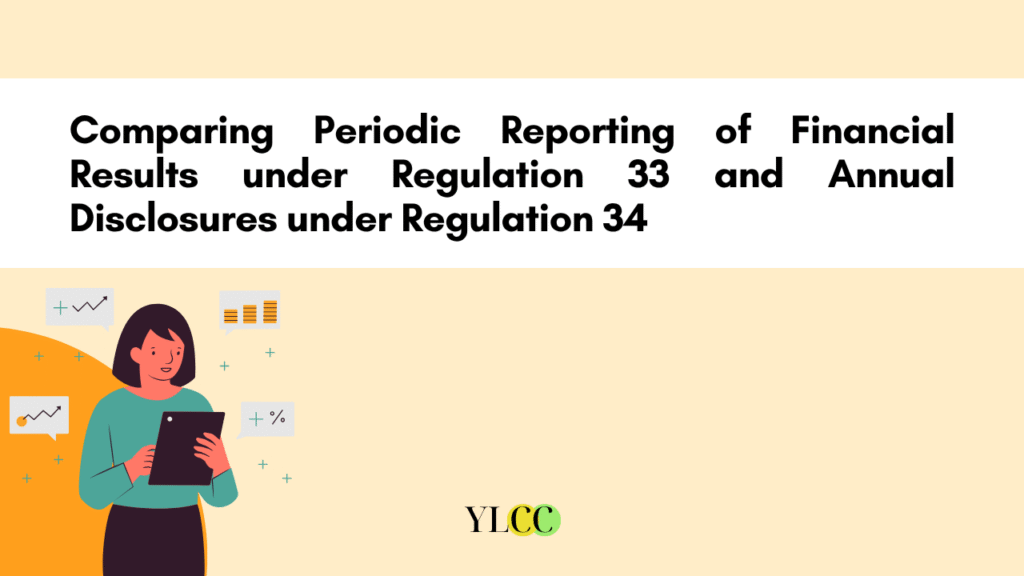
1. INTRODUCTION
The word ‘Corporate transparency’ isn’t just a catch line; it’s the backbone of investor confidence. The Securities and Exchange Board of India (SEBI), through the Listing Obligations and Disclosure Requirements (LODR) Regulations, 2015, has laid down specific guidelines to ensure that the companies provide punctual and authentic financial information. Regulation 33 and Regulation 34 stand out as key provisions governing financial disclosures. Usually, at first glance, both regulations seem to serve a similar purpose, i.e., guaranteeing economic transparency. However, when we look closer, it reveals that they function with fundamentally distinct objectives. It is understood that Regulation 33 mandates quarterly financial disclosures, thereby keeping the market informed of a company’s short-term performance. But when we look at Regulation 34, we can understand that it provides an in-depth annual review that covers everything from finance to corporate administration and sustainability.
Now the million-dollar question is, do these regulations really improve transparency, or do they merely add to compliance and regulatory burdens?
2. UNDERSTANDING REGULATION 33:
According to Regulation 33, it must ensure that the company is nurturing the culture of mandating quarterly financial disclosure. This is mainly to help the investors understand where their money has been streamlined and update them on their financial health. Under this regulation, it is said that the companies must publish any sort of unaudited quarterly results within 45 days of the quarter’s ending and the audited annual results, within 60 days of the financial year’s end. This reporting fashion helps the investors and assists the analysts in tracking the performance trends, deterring them from making wrong investment decisions in the dark.
The main focus of Regulation 33 is financial clarity through raw numbers. The Companies are instructed to reveal their profit and loss statements, balance sheets, and cash flow statements, along with a limited review report from auditors for quarterly results. Thus, making Regulation 33 an important tool for the short-term investors, stock market analysts, and regulatory bodies to monitor a company’s financial well-being in real time.
A notable case where quarterly disclosures under Regulation 33 significantly impacted investor sentiment was in Yes Bank’s financial crisis – 2019. The bank’s quarterly financial reports exposed rising bad loans and corporate governance failures, causing a sharp decline in its stock price. If such disclosures had been limited to annual reports, investors might not have realized the extent of the crisis until it was too late. This emphasizes the significance of frequent financial updates in maintaining market efficiency and protecting investor interests.
Very recently, on 26th March 2025, IndusInd Bank, the fifth-largest private-sector lender in India, had recently came under scrutiny due to major accounting abnormalities. The bank was involved in unapproved internal derivatives trading that went unrecorded after the Reserve Bank of India (RBI) banned such practices. As a result, IndusInd’s net worth is anticipated to decline by 2.35%, roughly $175 million, contributing to a 25% decrease in its market value of around $2 billion. The RBI has comforted the stakeholders that the bank’s solvency remains intact, yet this event emphasized an urgent need for stronger management in the banking industry. The bank’s board and risk management strategies are now facing intense examination, with Grant Thornton enlisted to probe potential fraud. This scenario recalls earlier governance failures in Indian banks, like those involving ICICI and Yes Bank, revealing enduring issues despite recent profitability successes.
Even though Regulation 33 provides fundamental financial understandings, it lacks depth in areas like governance, risk assessment, and long-term strategy. A company may post strong quarterly numbers while ignoring broader risks, which might mislead investors into a false sense of security. This is where Regulation 34 plays a crucial role.
3. UNDERSTANDING REGULATION 34:
Unlike Regulation 33, which focuses solely on financial numbers, Regulation 34 mandates the submission of a comprehensive annual reports that go beyond numbers to deliver a holistic idea of the company’s performance, governance, management, and strategic direction. Companies must file their annual reports within 21 working days after the Annual General Meeting (AGM), ensuring that shareholders have full visibility into the organization’s affairs before making major decisions.
An essential feature of Regulation 34 is its priority on Management Discussion and Analysis (MD&A), corporate governance disclosures, and sustainability reporting. Companies are required to detail their risk management strategies, ESG (Environmental, Social, and Governance) commitments, and future business outlook, giving investors a well-rounded perspective on the company’s stability and ethical standing.
An example of the power of annual reporting under Regulation 34 is the case of Infosys. The company’s annual reports have long been considered a benchmark for corporate governance and transparency. In its 2022-23 annual report, Infosys provided detailed disclosures on its digital transformation strategy, risk mitigation frameworks, and sustainability initiatives, offering investors deep insights into its long-term business approach.
Despite its advantages, Regulation 34 is not without defects. Many companies use excessive legal jargon and vague statements to mask critical risks or negative financial trends, another common trend adopted by companies to trick their investors. Some investors find annual reports too lengthy and complex, making it difficult to extract meaningful information. Subsequently, by the time an annual report is published, the information may already be outdated, reducing its relevance in fast-changing market conditions.
4. COMPARISON: ARE THEY COMPLEMENTARY OR REDUNDANT?
Regulation 33 and Regulation 34 are not synonymous, but they complement each other. Quarterly financial reports keep investors informed in real time, preventing any sort of surprises at year-end, while annual reports provide a deep dive into long-term plans, governance, and sustainability. However, their effectiveness depends on how companies and investors utilize them.
For instance, during the COVID-19 pandemic, quarterly reports immensely helped the investors assess immediate financial impacts, while annual reports provided insights into how companies planned to recover and sustain operations in the long run. Without both regulations working together, investors would have struggled to make decisions.
CONCLUSION:
While we know that Regulation 33 ensures that investors receive economic updates through quarterly outcomes, Regulation 34 guarantees a broader picture of a company’s financial well-being, governance, and sustainability efforts through annual reports. Despite these frameworks, the organization ensures that it is adhering to the technicalities of compliance without offering genuine clarity. Many companies often engage in simple disclosure methods to meet the regulatory conditions while withholding critical financial stress indicators, leading to potential investor misinformation.
To address these challenges, SEBI must embrace more stringent enforcement mechanisms to prevent fussy or misleading disclosures. Improving auditing independence, randomized forensic audits, and automated AI-based monitoring systems can help detect anomalies in financial reporting. Furthermore, making CFOs and board members personally liable for misstatements would serve as a deterrent. Establishments should also be required to present clear & concise, investor-friendly reports, ensuring that financial statements are not just regulatory formalities but effective tools for informed decision-making.
BIBLIOGRAPHY
- https://www.sebi.gov.in/legal/regulations/jul-2024/securities-and-exchange-board-of-india-listing-obligations-and-disclosure-requirements-regulations-2015-last-amended-on-july-10-2024-_84817.html
- https://ca2013.com/lodr-regulation-33/
- https://www.sebi.gov.in/sebi_data/meetingfiles/apr-2023/1681702875120_1.pdf
- https://www.argus-p.com/updates/updates/sebi-informal-guidance-regulation-333b-of-the-lodr/
- https://www.teamleaseregtech.com/updates/article/4491/sebi-mandates-disclosure-of-reasons-for-delay-in-submission-of-financi/
- https://www.mmjc.in/frequently-asked-questions-on-integrated-filing-financials-for-quarter-ended-december-31-2024/
- https://www.clearias.com/yes-bank-crisis-reconstruction/?utm
- https://www.scconline.com/blog/post/2023/10/21/landmark-judgments-on-sebi-by-supreme-court-and-high-courts-in-2022-part-ii/?
- https://papers.ssrn.com/sol3/papers.cfm?abstract_id=4926736#:~:text=Yes%20Bank%20was%20suffering%20from,sectors%20like%20power%20and%20infrastructure.
- https://www.reuters.com/world/india/india-file-disclosure-snafu-reveals-banking-risks-2025-03-26/?utm
This article has been written by Zynah Basheer. For any other queries, reach out to us at: queries.ylcc@gmail.com






